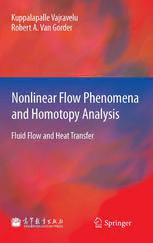
Nonlinear Flow Phenomena and Homotopy Analysis: Fluid Flow and Heat Transfer PDF
Preview Nonlinear Flow Phenomena and Homotopy Analysis: Fluid Flow and Heat Transfer
Kuppalapalle Vajravelu Robert A. Van Gorder Nonlinear Flow Phenomena and Homotopy Analysis Fluid Flow and Heat Transfer 123 Kuppalapalle Vajravelu Robert A. Van Gorder (cid:47)(cid:80)(cid:79)(cid:77)(cid:74)(cid:79)(cid:70)(cid:66)(cid:83)(cid:1)(cid:39)(cid:77)(cid:80)(cid:88)(cid:1)(cid:49)(cid:73)(cid:70)(cid:79)(cid:80)(cid:78)(cid:70)(cid:79)(cid:66)(cid:1) (cid:66)(cid:79)(cid:69)(cid:1)(cid:41)(cid:80)(cid:78)(cid:80)(cid:85)(cid:80)(cid:81)(cid:90)(cid:1)(cid:34)(cid:79)(cid:66)(cid:77)(cid:90)(cid:84)(cid:74)(cid:84) Fluid Flow and Heat Transfer Kuppalapalle Vajravelu Robert A. Van Gorder Nonlinear Flow Phenomena and Homotopy Analysis Fluid Flow and Heat Transfer With 71 figures 3 Authors KuppalapalleVajravelu RobertA.vanGorder DepartmentofMathematics DepartmentofMathematics UniversityofCentralFlorida UniversityofCentralFlorida OrlandoFlorida32816-1364,USA OrlandoFlorida32816-1364,USA E-mail:kvajravelu@cfl.rr.com E-mail:[email protected] ISBN978-7-04-035449-2 HigherEducationPress,Beijing ISBN978-3-642-32101-6 ISBN978-3-642-32102-3 (eBook) SpringerHeidelbergNewYorkDordrechtLondon LibraryofCongressControlNumber:2012943603 (cid:2)c HigherEducationPress,BeijingandSpringer-VerlagBerlinHeidelberg2012 Thisworkissubjecttocopyright. AllrightsarereservedbythePublishers,whetherthewholeorpartof thematerialisconcerned,specificallytherightsoftranslation,reprinting,reuseofillustrations,recitation, broadcasting,reproductiononmicrofilmsorinanyotherphysicalway,andtransmissionorinformation storageandretrieval,electronicadaptation,computersoftware,orbysimilarordissimilarmethodology nowknownorhereafterdeveloped.Exemptedfromthislegalreservationarebriefexcerptsinconnection withreviewsorscholarlyanalysisormaterialsuppliedspecificallyforthepurposeofbeingenteredand executedonacomputersystem,forexclusiveusebythepurchaserofthework. Duplicationofthispub- licationorpartsthereofispermittedonlyundertheprovisionsoftheCopyrightLawofthePublishers’ locations,initscurrentversion,andpermissionforusemustalwaysbeobtainedfromSpringer. Permis- sionsforusemaybeobtainedthroughRightsLinkattheCopyrightClearanceCenter.Violationsareliable toprosecutionundertherespectiveCopyrightLaw. Theuseofgeneraldescriptivenames,registerednames,trademarks,servicemarks,etc.inthispublication doesnotimply,evenintheabsenceofaspecificstatement,thatsuchnamesareexemptfromtherelevant protectivelawsandregulationsandthereforefreeforgeneraluse. Whiletheadviceandinformationinthisbookarebelievedtobetrueandaccurateatthedateofpubli- cation,neithertheauthorsnortheeditorsnorthepublisherscanacceptanylegalresponsibilityforany errorsoromissionsthatmaybemade.Thepublishersmakenowarranty,expressorimplied,withrespect tothematerialcontainedherein. Printedonacid-freepaper SpringerispartofSpringerScience+BusinessMedia(www.springer.com) Foreword “Theessenceofmathematicsliesentirelyinitsfreedom” byGeorgCantor(1845—1918). Solvingnonlinearproblemsisinherentlydifficult.Perturbationtechniquesaremostly usedtogainanalyticapproximationsofnonlinearequations.Unfortunately,pertur- bationmethodsdependtooheavilyonsmallphysicalparameters,andperturbative resultsarevalidonlyincasesofweaknonlinearity.Althoughsomenon-perturbation techniques were developed to overcome the restrictions of perturbation methods, neitherofthemcanguaranteetheconvergenceofapproximationseries. Thehomotopyanalysismethod(HAM)isapromisinganalyticmethodforhighly nonlinearequations,whichhasbeensuccessfullyappliedinscience,appliedmath- ematics,finance,andengineering.Basedontheconceptofhomotopyintopology, thehomotopyanalysismethodisbeingdevelopedtosolvenonlinearproblemsinde- pendentofanysmallphysicalparameters.Especially,theHAMintroducesatotally newconcept“convergence-control”bymeansofthe“convergence-controlparam- eter” that provides a simple way to guarantee the convergence of approximation series.Infact,itis the“convergence-controlparameter”thatmakestheHAMdif- ferentfromallofotheranalyticmethods.Asaresult,unlikeotheranalyticmethods, theHAMisvalidforhighlynonlinearproblems. Thankstocontributionsofmanyresearchersindozensofcountries,theHAMhas beendevelopedandmodifiedgreatlyintheory,andwidelyappliedinmanyfields. Written by two outstanding scholars, the book “Nonlinear Flow Phenomena and Homotopy Analysis” describes some theoretical developments and new attempts oftheHAM, togetherwith typicalapplicationsinflowandheattransferoffluids. Especially,theauthorsdiscussthechoiceofinitialguess,auxiliarylinearoperator, auxiliaryfunction,convergence-controlparameterandso on,fromthe viewpoints ofappliedmathematician.Theselectedexamplesarefundamentalinnatureandare importantfornewuserstounderstandandusetheHAM.Obviously,thisbookisof benefittotheadvancementandwideapplicationoftheHAM. ShijunLiao May26th2012 Preface Overthelastdecade,thehomotopyanalysismethodhascomeintoprevalenceasit allowsonetoconstructreasonablyaccurateapproximationstononlineardifferential equations.Awidevarietyofmathematicalproblems,appearinginareasasdiverse asfluidmechanics,chemicalengineering,biology,finance,theoreticalphysicsand aerospaceengineering,havebeensolvedbymeansofhomotopyanalysis.Though, thehomotopyanalysismethodisfrequentlyemployedintheliterature,therearestill anumberofquestionswhichremainopenregardingthemethod,dueinparttothe generalityofthemethod. In the present monograph,we highlight some of the key points which need to be understoodby those workingin appliedmathematics, physics and applied sci- enceandengineeringinordertoapplythehomotopyanalysismethod.Thatis,the book helps the reader to developthe toolset needed to apply the method,without siftingthroughtheendlessliteratureonthearea.Issuesoftheoptimalselectionof theauxiliarylinearoperator,auxiliaryfunction,convergencecontrolparameter,and initialapproximations,arediscussedheuristically.Furthermore,advancedandless frequentlyseenmethods,suchasmultiplehomotopiesandnonlinearauxiliaryoper- ations,arediscussed.Asmentionedabove,thereareverymanyapplicationsofthe homotopy analysis method in the literature. In selecting applications and specific problems to work through, we have restricted our attention to the fluid phenom- ena of fluid flow and heat transfer as such problems introduce a wide variety of mathematicalproblemsyetallowforasufficientlynarrowfocus.Hence,inorderto illustratevariouspropertiesandtoolsusefulwhenapplyingthehomotopyanalysis method,wehaveselectedrecentresearchintheareaoffluidflowandheattransfer. Weappreciatethesupportandmotivationofprof.A.C.-J.Luo.Wealsoacknowl- edgetheroleofHigherEducationPress(China)andSpringerformakingthisbook areality.K.V.Prasadhelpedintypingsomeoftheexamples. Orlando,Florida KuppalapalleVajravelu 2012 RobertA.VanGorder Contents 1 Introduction................................................... 1 References..................................................... 3 2 PrinciplesofHomotopyAnalysis................................. 7 2.1 Principlesofhomotopyandthehomotopyanalysismethod........ 7 2.2 Constructionofthedeformationequations...................... 9 2.3 Constructionoftheseriessolution ............................ 11 2.4 Conditionsfortheconvergenceoftheseriessolutions ............ 12 2.5 Existenceanduniquenessofsolutionsobtainedbyhomotopy analysis................................................... 14 2.6 Relationsbetweenthe homotopyanalysismethodandother analyticalmethods.......................................... 14 2.7 HomotopyanalysismethodfortheSwift-Hohenbergequation ..... 14 2.7.1 Applicationofthehomotopyanalysismethod ............ 16 2.7.2 Convergenceoftheseriessolutionanddiscussionof results.............................................. 17 2.8 Incompressibleviscousconductingfluidapproachinga permeablestretchingsurface ................................. 21 2.8.1 Exactsolutionsforsomespecialcases................... 23 2.8.2 ThecaseofG(cid:2)=0.................................... 25 2.8.3 ThecaseofG=0.................................... 29 2.8.4 Numericalsolutionsanddiscussionoftheresults.......... 32 2.9 Hydromagneticstagnationpointflowofasecondgradefluidover astretchingsheet........................................... 34 2.9.1 Formulationofthemathematicalproblem................ 38 2.9.2 Exactsolutions ...................................... 38 2.9.3 Constructinganalyticalsolutionsviahomotopyanalysis.... 40 References..................................................... 46 x Contents 3 MethodsfortheControlofConvergenceinObtainedSolutions...... 53 3.1 Selectionofthe auxiliarylinear operatorandbase function representation.............................................. 53 3.1.1 Methodoflinearpartitionmatching..................... 56 3.1.2 Methodofhighestorderdifferentialmatching ............ 57 3.1.3 Methodofcompletedifferentialmatching................ 58 3.1.4 Initialversusboundaryvalueproblems .................. 59 3.1.5 Additionaloptionsfortheselectionofanauxiliary linearoperator....................................... 60 3.1.6 Remarksonthesolutionexpression..................... 60 3.2 Theroleoftheauxiliaryfunction ............................. 61 3.3 Selectionoftheconvergencecontrolparameter.................. 63 3.4 OptimalconvergencecontrolparametervalueandtheLane-Emden equationofthefirstkind..................................... 65 3.4.1 Physicalbackground ................................. 65 3.4.2 AnalyticsolutionsviaTaylorseries ..................... 66 3.4.3 Analyticsolutionsviahomotopyanalysis ................ 69 References..................................................... 75 4 AdditionalTechniques .......................................... 77 4.1 Constructionofmultiplehomotopiesforcoupledequations ....... 77 4.2 Selectionofanauxiliarynonlinearoperator..................... 79 4.3 Validationoftheconvergencecontrolparameter................. 80 4.3.1 Convergencecontrolparameterplots(“h¯-plots”) .......... 80 4.3.2 Minimizedresidualerrors ............................. 80 4.3.3 Minimizedapproximateresidualerrors.................. 82 4.4 Multiplehomotopiesandtheconstructionofsolutionstothe Fo¨ppl-vonKa´rma´nequationsgoverningdeflectionsofathin flatplate .................................................. 82 4.4.1 Physicalbackground ................................. 82 4.4.2 Linearizationandconstructionofperturbationsolutions.... 84 4.4.3 Recursivesolutionsfortheclampededgeboundarydata.... 85 4.4.4 Specialcase:Thethinplatelimith→0,ν2→1........... 87 4.4.5 Controloferrorandselectionoftheconvergencecontrol parameters.......................................... 88 4.4.6 Results............................................. 90 4.5 Nonlinearauxiliaryoperatorsandlocalsolutionstothe Drinfel’d-Sokolovequations ................................. 91 4.6 RecentworkonadvancedtechniquesinHAM .................. 97 4.6.1 Mathematicalpropertiesof h¯-curveintheframeworkof thehomotopyanalysismethod ......................... 97 4.6.2 Predictorhomotopyanalysismethodanditsapplicationto somenonlinearproblems.............................. 98 4.6.3 Anoptimalhomotopy-analysisapproachforstrongly nonlineardifferentialequations......................... 98 Contents xi 4.6.4 On the homotopymultiple-variablemethodandits applicationsintheinteractionsofnonlineargravity waves.............................................. 98 References..................................................... 99 5 ApplicationoftheHomotopyAnalysisMethodtoFluidFlow Problems......................................................101 5.1 ThinfilmflowofaSiskofluidonamovingbelt .................102 5.1.1 Mathematicalanalysisoftheproblem ...................103 5.1.2 Applicationofthehomotopyanalysismethod ............106 5.1.3 Numericalresultsanddiscussion .......................108 5.2 Nanoboundarylayersoverstretchingsurfaces ..................112 5.2.1 Formulationoftheproblem............................113 5.2.2 Applicationofthehomotopyanalysismethod ............115 5.2.3 Analyticalsolutionsviathehomotopyanalysismethod ....116 5.2.4 Numericalsolutions..................................118 5.2.5 Discussionoftheresults ..............................121 5.3 Rotatingflowofathirdgradefluidbyhomotopyanalysis method ...................................................123 5.3.1 Mathematicalformulation.............................124 5.3.2 Solutionoftheproblem...............................126 5.3.3 Resultsanddiscussions ...............................129 5.4 Homotopyanalysisforboundarylayerflowofamicropolarfluid throughaporouschannel ....................................133 5.4.1 Descriptionoftheproblem ............................134 5.4.2 HAMsolutionsforvelocityandmicro-rotationfields ......136 5.4.3 Convergenceofthesolutions ..........................139 5.4.4 Resultsanddiscussion................................140 5.5 Solution of unsteady boundary-layerflow caused by an impulsivelystretchingplate ..................................142 5.5.1 Mathematicaldescription .............................143 5.5.2 Homotopyanalyticsolution ...........................145 5.5.3 Resultsanddiscussion................................147 References.....................................................151 6 FurtherApplicationsoftheHomotopyAnalysisMethod............157 6.1 Seriessolutionsofanonlinearmodelofcombinedconvectiveand radiativecoolingofaspherical ...............................157 6.1.1 Basicequations......................................157 6.1.2 SeriessolutionsgivenbytheHAM .....................159 6.1.3 Resultanalysis ......................................164 6.1.4 Conclusionsanddiscussions...........................169 6.2 Anill-posedproblemrelatedtotheflowofathinfluidfilmover asheet....................................................171 6.2.1 Introductionandphysicalmotivation....................171 xii Contents 6.2.2 Formulationofthethree-parameterproblem..............173 6.2.3 Arelatedfour-parameterill-posedproblem...............175 6.2.4 Analyticalsolutionfor f(η)viathehomotopyanalysis method.............................................178 6.2.5 Resultsanddiscussion................................181 References.....................................................184 SubjectIndex ......................................................185 AuthorIndex ......................................................187
